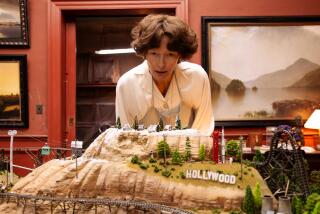A Walk Through the Ice Fields of a Son’s Grief
- Share via
Miriam Kamenetz was a pent-up, volatile woman. Swinging between highs and lows, she loved her family fiercely, making the brick walls of their Baltimore home vibrate with her outpourings of emotion. As her son, Rodger, describes her in “Terra Infirma,” she might have come straight out of a modern version of Euripides--the Medea of the suburbs. And yet, when she died at 54 of colon cancer, she had shrunk into a little old lady, with bones so brittle that the bump of floor tiles under her wheelchair would send her into agony.
All that rage and misspent aggression, the frustrations of a lifetime, were gone, sucked away, leaving her son with stirred up feelings and unanswered questions. “Terra Infirma” is Kamenetz’s effort to understand the sound and fury of his mother’s life and--hopefully--to enlighten readers along the way.
“No one wants to read about death,” Kamenetz says. “The subject matter repulses thought. . . . Yet the pattern of every life is instructive, and an ordinary death may be as tragic as ‘Oedipus.’ ” Beautifully written, rich in the economy of phrasing and imagery that has marked Kamenetz’s career as a poet, “Terra Infirma” is his substitute for the kaddish, that ancient prayer of mourning traditionally uttered by Jewish children when a parent dies. Instead, it is a walk through the ice fields of grief, in search (as the book’s title implies) of firmer ground.
In his previous books, “The Jew in the Lotus” and “Stalking Elijah,” Kamenetz explored the mystical roots that Judaism shares with Tibetan Buddhism. He probed the ways that religions perceive God’s ultimate reality.
Yet the probing in “Terra Infirma” is more personal. Three questions hover over the book like a dark cloud: Why did Miriam forfeit her life by refusing a stronger treatment of her disease? What did love really mean to this complicated woman? And why did her son, whom she called her “sunshine boy,” avoid her in her hour of need?
Kamenetz finds answers in the past. Miriam hid the story of her life from her children--she pretended “that her parents never existed, that she herself never existed until she became our mother”--but she finally shared the truth on her deathbed. Kamenetz writes of his mother’s magnificent, stubborn will; how it grew strong under the blows of her early life (imagine a hot iron hammered by a blacksmith), and how, fatally, it molded her to fight against all things, including the strident advice of her doctors.
With Kamenetz’s pen, family portraits are deftly sketched. There’s Benjamin, his grandfather, a frustrated Talmud scholar-turned-barber; Benjamin’s wife, Agnes, whom he beat and who was later institutionalized; Kamenetz’s father, Irvin, a shopkeeper (meekly in the story’s background) who regretted not studying medicine; and, with her own disappointments, Miriam.
We learn that she lived with a foster family after Benjamin and Agnes’ life fell apart. Her son broods on this, feeling that this might be why Miriam “had directed her energy toward one goal, keeping her family together.” It was an energy that took shape in spurts of redecorating and housecleaning and the showers of anger and affection that rained on her children.
Only when the specter of cancer loomed did Miriam start thinking of herself. She finished school and found a job, racing against her illness. In that time, mother and son had been drifting apart. Miriam’s cancer was detected while Kamenetz studied in Mexico; not wanting to spoil his trip, she quietly underwent a lesser treatment that failed to prevent a later metastasis.
Kamenetz, however, can’t plead ignorance. Phone calls from home alluded to something wrong. “I turned my back on it. I didn’t want to be pulled back to her,” he confesses, thinking that had he been there, he might have broken her resistance, which felt it could beat any odds, and convinced her to make a better choice. This moment, one senses, is what the author has been working toward since the book’s opening. His road to adulthood, Kamenetz recognizes, has had many painful turns.
After her death, Miriam’s spirit offers Kamenetz Zen-like consolation. The chaos of life, she reminds him in a dream, is “connected in the spirit, part of a single motion, like a wave through water.”
Is there something instructive in this, as Kamenetz hopes? There is, even though “Terra Infirma” is not a self-help book for the grieving. Few are chosen to face really great trials: to lead an army into battle or argue an important case before the Supreme Court. There are many whose struggles are hidden in ordinary lives. The greatest tribute a child can give, beyond the kaddish, a memorial or any other obsequies, is to find that heroism where it lay hidden, as Kamenetz does, and to say, “I understand.”
*
Nick Owchar is an assistant editor of Book Review.
More to Read
Sign up for our Book Club newsletter
Get the latest news, events and more from the Los Angeles Times Book Club, and help us get L.A. reading and talking.
You may occasionally receive promotional content from the Los Angeles Times.







